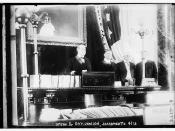Affirmative action includes the policies and programs, either voluntary or mandated by law, that aim to increase the number of historically disadvantaged people, such as women and minorities, in education or the workforce. Women were initially excluded from affirmative action initiatives, but due to publicity and pressure from some women's groups, women were finally added in April 1973 (Johnson, 1989, p. 114, 116). This literary review will cover a brief history of affirmative action, the various arguments for and against it, and whether different authors believe it should continue to be used.
To start off, it is important to examine why affirmative action for women exists at all. A number of the articles were written by people who agreed with affirmative action due to be exposed to and disturbed by sexism in the workplace. For example, in 1954 Gerhard Weinberg (1996) was a member of a committee for the University of Chicago that awarded fellowships, but "the department did not, as a matter of policy, award fellowships to women...[because]
the department had very few fellowships and did not want to 'waste' these on women who were likely to get married and not have academic careers anyway"-a policy Weinberg found to be unfair (p. 324). González (2006) noted that only 3 out of the 50 faculty members in the history department at Berkeley in the 1970's were women (p. 158). Brodkin (2000) considers herself a "second-wave feminist" who also felt that there was a lot of gender inequality before affirmative action was instated (p.1223). Affirmative action was initially started in an attempt to increase the number of women in the workforce and academia due to the fact that there were underrepresented, or in some cases nonexistent in certain fields.
While the Civil Rights Act of 1964 made it illegal for employers...

![[Portrait of Bunk Johnson and Maude Johnson, Stuyvesant Casino, New York, N.Y., ca. June 1946] (LOC)](https://s.writework.com/uploads/17/171599/portrait-bunk-johnson-and-maude-johnson-stuyvesant-casino-n-thumb.jpg)
